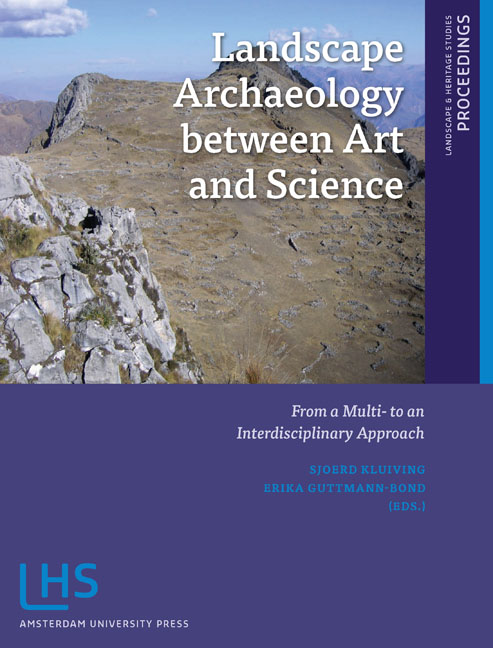Book contents
- Frontmatter
- Contents
- Preface
- Introduction: LAC2010: First International Landscape Archaeology Conference
- THEME 1 HOW DID LANDSCAPE CHANGE?
- THEME II IMPROVING TEMPORAL, CHRONOLOGICAL AND TRANSFORMATIONAL FRAMEWORKS
- THEME III LINKING LANDSCAPES OF LOWLANDS TO MOUNTAINOUS AREAS
- THEME IV APPLYING CONCEPTS OF SCALE
- THEME V NEW DIRECTIONS IN DIGITAL PROSPECTION AND MODELLING TECHNIQUES
- THEME VI HOW WILL LANDSCAPE ARCHAEOLOGY DEVELOP IN THE FUTURE?
- Miscellaneous Endmatter
1.6 - The Evolution of an Agrarian Landscape. Methodological Proposals for the Archaeological Study of the Alluvial plain of Medellin (Guadiana Basin, Spain)
Published online by Cambridge University Press: 21 January 2021
- Frontmatter
- Contents
- Preface
- Introduction: LAC2010: First International Landscape Archaeology Conference
- THEME 1 HOW DID LANDSCAPE CHANGE?
- THEME II IMPROVING TEMPORAL, CHRONOLOGICAL AND TRANSFORMATIONAL FRAMEWORKS
- THEME III LINKING LANDSCAPES OF LOWLANDS TO MOUNTAINOUS AREAS
- THEME IV APPLYING CONCEPTS OF SCALE
- THEME V NEW DIRECTIONS IN DIGITAL PROSPECTION AND MODELLING TECHNIQUES
- THEME VI HOW WILL LANDSCAPE ARCHAEOLOGY DEVELOP IN THE FUTURE?
- Miscellaneous Endmatter
Summary
ABSTRACT
In this paper we introduce the background, objectives and initial results of a regional research project focused on the evolution of the agrarian landscape in the Medellin alluvial plain (Badajoz province, Spain). From several different fields we face the task of analysing the changing role of this settlement as a political and administrative centre placed at a key point in communications of the Peninsular southwest. At the same time, we assess the methodological challenges of defining distinct territories based on the archaeological record in an area which has been severely affected by geomorphological processes, and which has also been disturbed by intensive agricultural activity in recent years. Firstly, basic criteria for the surface survey are explained. The workflow is explained from the definition of survey areas to the analysis of spatial distribution of finds. Secondly, we will show the preliminary results of the geomorphological interpretation and mapping of the study area. This is the starting point for a suitability model for the analysis of the interaction between factors that determine our perception of surface archaeological evidence. The objective is the elaboration of a map that would help to evaluate the degree of terrain stability, as a means to assess the representativeness of the surface record and potential risks for conservation.
KEYWORDS
agrarian landscapes, Archaeological survey, alluvial geoarchaeology, protohistory, Romanisation, Medellin (Spain)
INTRODUCTION: ALLUVIAL LANDSCAPES: GEOMORPHOLOGICAL PROCESSES, HUMAN IMPACT AND THEIR EFFECT ON THE PRESERVATION OF THE ARCHAEOLOGICAL RECORD
It has been established that the visibility and preservation of the archaeological record is strongly influenced by the complex interaction of many different factors, both natural and induced by human intervention. As a result, it is unwise to undertake any survey project without providing a detailed study of the dynamics generated by these elements. In this regard, Mediterranean landscapes present a strong challenge because of the complexity of geomorphic processes, soil erosion and a long history of intensive land use (see for example Bintliff 2005; van Andel et al. 1990). In particular, alluvial landscapes offer a changing environment, sometimes at a rapid pace, making it difficult to interpret the meaning of surface finds. Simply assuming that these areas are too modified for systematic study is unsatisfactory, since extreme cases of hidden or vanished remains coexist with areas of better conservation.
- Type
- Chapter
- Information
- Landscape Archaeology between Art and ScienceFrom a Multi- to an Interdisciplinary Approach, pp. 97 - 114Publisher: Amsterdam University PressPrint publication year: 2012
- 2
- Cited by

